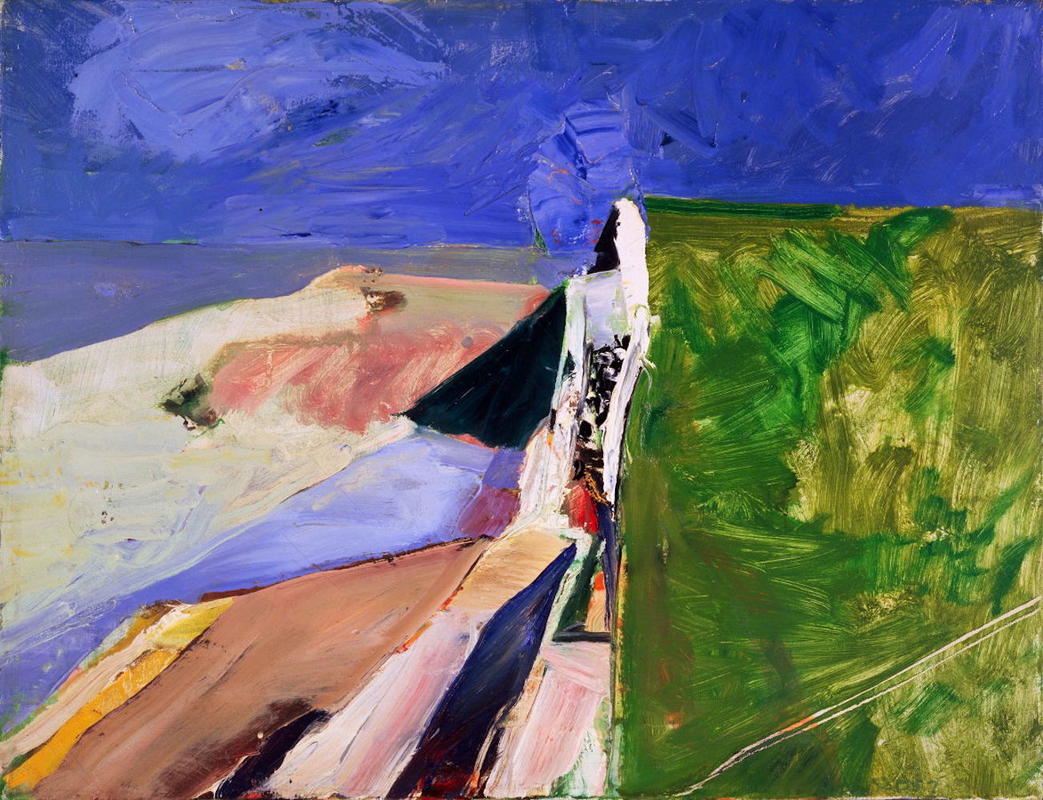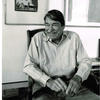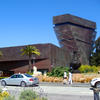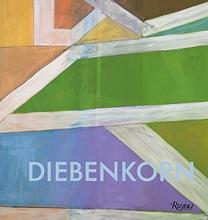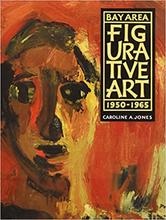More about Seawall
- All
- Info
- Shop
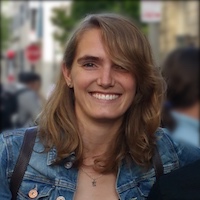
Contributor
In the tilting carnival ride of Seawall, Richard Diebenkorn gives the impression of a dizzy kid gazing at the seaside landscape of California as the ride continues to spin.
As a whole, a viewer can make out the cliffs of Point Reyes - or at least some coastal cliffs - but the devil’s in those abstract details. The patchwork of abstract shapes and colors provides an elemental encounter with an abstract earth, sea and sky.
The title, Seawall, encourages viewers to envision - thus drives them to find - a lovely seaside landscape in the confines of the canvas, while Diebenkorn’s thick, roughly applied brushstrokes create blocks of distinct, solitary colors in stacked planes that unsettle that placid assumption. Though he gives us the intellectual name of the subject, the segmentation of the landscape through bold shapes and blocks of color places the viewer on the unsteady legs of our carnival experience. This confounding dialogue between the representational name and abstract design draws the audience in, giving the mind and eye a bewildered spinning sensation.
While Diebenkorn formed, reworked and explored his artistic style - in all of its baffling glory - he had a one major champion, his wife, Phyllis. As Diebenkorn painted and sketched away, Phyllis actively catalogued each painting and drawing, helped to mount exhibitions, and acted as his main model and muse. Richard and Phyllis met at Stanford University in 1940 and never strayed far from the Bay Area. Richard was profoundly influenced by the area’s natural habitat and cultural environment, helping him to become the abstract expressionist painter we know and love. But perhaps the biggest influence on Diebenkorn’s career was meeting, and subsequently marrying, Phyllis Gilman.
With small stints in Albuquerque and New York, Richard and Phyllis returned to the Bay Area throughout their lives. Not only was Richard’s first solo exhibition at the Legion of Honor in San Francisco but his artistic vision was formed by his Berkeley years and Oak Park series. Their connection remained even after Diebenkorn’s death in 1993. In 2007, Phyllis formed the Richard Diebenkorn Foundation to continue her role cataloguing and sharing the work of her husband with the world; she even donated important works, like Seawall, to the de Young Museum in San Francisco. Phyllis loved that artistic carnival ride her husband created, and rode it to the very end and I think we should join her.
So jump on and get ready. In Seawall, the dizzying array of boxy landscape and blotchy sky integrates the predicted representational forms of a landscape with the gestural brushstrokes and emphasis on paint and canvas that defined Abstract Expressionism. As part of that creed of artistic freedom, Diebenkorn believed that “mistakes can’t be erased but they move you from your present position.” As he added more paint, more color and more texture, Diebenkorn challenged our expectations, painting the familiar landscapes of the Bay Area in startling and distorted ways. He never makes us stray too far from the place we love, but boy does he create a great ride in the process.
Sources
- Carey-Kent. “Richard Diebenkorn at the Royal Academy: Six Painters on a Painters’ Painter.” ArtCritical. ArtCritical, 4 May 2015. Web. 17 July 2017. http://www.artcritical.com/2015/05/04/paul-carey-kent-richard-diebenkor…
- Maloney, Patricia. “Richard Diebenkorn: The Berkeley Years, 1953-1966.” Art Practical. Art Practical, 11 September 2013. Web. 30 July 2017. http://www.artpractical.com/review/richard-diebenkorn-the-berkeley-year…
- “Richard Diebenkorn: The Berkeley Years, 1953-1966.” FAMSF. Fine Arts Museums of San Francisco, April 2013. Web. 20 June 2017. https://www.famsf.org/press-room/richard-diebenkorn-berkeley-years-1953…
- “Seawall, Richard Diebenkorn.” Google Arts & Culture. De Young Museum, 2010. Web. 25 June 2017. https://www.google.com/culturalinstitute/beta/asset/seawall/NwH14XGW7JJ…
- Whiting, Sam. “Phyllis Diebenkorn, famed artist’s widow and psychologist, dies.” SFGate. SFGate, 29 January 2015. Web. 15 August 2017. http://www.sfgate.com/bayarea/article/Phyllis-Diebenkorn-famed-artist-s…
- Livingston, Jane. “Biography.” Richard Diebenkorn Foundation. Richard Diebenkorn Foundation, 2017. Web. 15 August 2017. http://diebenkorn.org/the-artist/biography/

